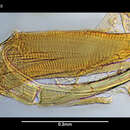pt-BR
nomes no trilho de navegação


"Spinacopia octo, new species FIGURES 15-17
HOLOTYPE—USNM 123541, male juvenile, length 2.37 mm, height 1.93 mm.
PARATYPE—USNM 123542, male juvenile, length 2.34 mm, height 1.92 mm.
TYPE-LOCALITY—Antarctic Ocean, lat. 70°ll'S, long. 106°38'-106°26'W; bottom depth 3495; station 931, cruise 11, RV Eltanin, 20 January 1964. Collected in 5-foot Blake trawl by University of Southern California. Smithsonian Oceanographic Sorting Center reference number 58. Both specimens were collected in same sample. Bottom temperature 0.34°C, bottom salinity 34.700 parts per thousand—data from Lamont Geological Observatory Station 248.
ETYMOLOGY—Specific name from the Latin noun octo (eight) for the ornamentation on the carapace, which vaguely resembles the figure 8.
DESCRIPTION OF JUVENILE MALE (instar IV?)— Carapace oval in lateral view with shallow incisur and short caudal process.
Ornamentation: Surface with short spines, many of these having parallel sides except near tip; long hairs present along ventral and anterior margins; narrow rim present slightly within and parallel to valve edge; posterodorsal part of each valve with about 4 pits vaguely defined by low marginal ridges.
Infold: Infold below incisur with minute bristle near inner margin; infold in front of caudal process with 9 bristles, 5 large spinous bristles above and 4 bristles below (latter bristles were obscured somewhat by debris so that whether or not they are spinous could not be observed); minute bristles present at inner margin of infold of caudal process.
Selvage: Lamella prolongation with smooth outer margin present along anterior, ventral, and posterior margins of both valves; prolongation continuous across incisur.
Muscle scars: Central scars consisting of about 12 oval scars.
Pore canals: Normal for genus.
Size: The dimensions of two juvenile males (instar IV?) are as follows:
Specimen
Length (mm)
Height (mm)
Remarks
USNM 123541
2.37
1.93
Holotype
USNM 123542
2.34
1.92
Paratype
First antenna: Similar to S. antarctica.
Second antenna: Endopodite 2- jointed: 1st joint with 2 or 3 small bristles; 2nd joint with 2 spinous bristles proximally, 1 long, 1 medium, and 1 short bare terminal bristle. Exopodite: 1st joint with short medial spine; 9th joint with 1 short and 1 long bristle; joints 2-8 with comb of short spines along distal margins.
Mandible: Similar to S. antarctica. Distal group of bristles near ventral margin of basal with 1 short spine on medial surface, 1 long spinous marginal bristle and 3 short bristles forming row on lateral surface.
Maxilla: Similar to S. antarctica. Endite I with 6 or 7 bristles; endite II with 5 or 6 bristles; endite III with 5 or 6 bristles.
Fifth limb: Endite with 1 bare bristle. Exopodite: 1st joint with 4 bristles; 2nd joint with 5 bristles; small bristle between joints 2 and 3; 3rd joint with 3 or 4 bristles on inner lobe and 1 on outer lobe; joints 4 + 5 with 4 or 5 bristles; surface of joints hirsute. Epipodial appendage with 43 bristles.
Sixth limb: Endite I with 1 long and 2 short bristles; endite II with 2 bristles; endite III with 3 bristles; endite IV with 4 bristles. End joint with 3 anterior bristles, 2 spinous bristles near middle, and 1 or 2 stout hirsute posterior bristles; clusters of hairs present on medial and lateral surfaces and along margin of end joint on each side of posterior bristles.
Seventh limb: Proximal group with 5 bristles, distal group with 6, each bristle with 2-4 bells and marginal spines distally; terminus with a few short teeth projecting vertically from end of limb.
Furca: Left lamella with 7 claws, right lamella with 8; claw 1 continuous with lamella, remaining claws separated from lamella by suture; claw 3 more slender and shorter than claw 4; claws 1, 2, 4, 5 with spines along posterior margin; clusters of hairs present medially at base of claw 1.
EYES, ROD-SHAPED ORGAN, UPPER LIP, POSTERIOR: Similar to S. antarctica.
Copulatory organ: Undeveloped.
COMPARISONS—The configuration of pits and surrounding ridges in the posterodorsal part of each shell and the parallel-sided surface hairs distinguish S. octo from previously described species. This species is also larger than previously described species of Spinacopia with the exception of S. menziesi Kornicker, 1969. (It is possible that the pit and ridge structure of the shell is an artifact, occurring by collapse of the shell after death of the animal.)" (Kornicker 1970, p.24-26)
Spinacopia octo is een mosselkreeftjessoort uit de familie van de Sarsiellidae.[1] De wetenschappelijke naam van de soort is voor het eerst geldig gepubliceerd in 1970 door Kornicker.
Bronnen, noten en/of referenties